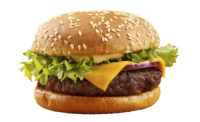The foodservice industry demands change as often as the limited-time offers (LTO) at your favorite restaurant and 2010 was no exception, saysMintel. The Chicago market researcher says that -- in light of the recent healthcare bill that requires restaurants with 20+ units to list calorie counts on the menu -- operators are now tasked with balancing federal regulations with the differing demands of their customers.
“Both the government and consumers want healthier menu options, but restaurant-goers are also very concerned about value and how their food tastes," says Eric Giandelone, Mintel's director of foodservice research. "Keeping both parties satisfied might be a challenge as we move into 2011.”
Restaurant-goers value menu transparency but still want the occasional
indulgent dining experience. Mintel says its Mintel Menu Insight’s
foodservice trends for 2011 "are all about walking that fine line
between open disclosure and customer satisfaction."
Trend #1: Healthy by association
Sixty-two percent of consumers say they plan to eat healthier in the upcoming year but many complain that healthier food doesn’t taste as good without the added sugar, sodium and fat. Restaurants will address this problem by swapping in ‘healthier’ ingredients to their patrons’ favorite dishes, and positioning them to appear better-for-you.
For instance, Taco Bell has quietly reduced sodium at 150 stores in the Dallas market, while Jason’s Deli promotes its food as being free from high-fructose corn syrup (HFCS), trans fats or pesticides. Consumers enjoy visiting restaurants that are perceived as healthy because these venues make them feel good about themselves and their meal choices. Consumers might opt to visit the ‘healthy’ restaurant, but be wooed by the not-so-healthy LTOs offered at these places (see Trend #5).
Trend #2: Automated menus
Convenience and technology will form the perfect union in 2011 as restaurant-goers see an increase in automated menus at their favorite establishments. These electronic order-takers will provide customers with the opportunity to order food to their specifications in do-it-yourself style, thus reducing the restaurant’s reliance on front-of-house staff, as well as full-time employees. Automated menus, in addition to mobile applications, will allow restaurants to reach a younger, more mobile consumer.
Trend #3: Transparency
Consumers want to know what they’re eating, and the recently passed healthcare bill mandates such disclosure. Restaurants with 20+ units are now required to list calorie counts on their menus. Consumers seem happy with the impending disclosure, as 61 percent agree that restaurants should post nutritional information, like calorie counts and fat grams, on menus. More cities will start forcing restaurants to visibly display their letter grades from local health departments, further increasing menu transparency.
Trend #4: Indigenous ingredients
While the local food movement continues to grow, the push toward indigenous ingredients takes that trend a step further. In 2011, restaurants will incorporate more traditional or authentic ingredients to their ethnic or globally-positioned entrees.
One example of this trend is Frontera Grill’s Panucho Yacateco, an entrée that boasts a traditional Yucatan crispy tortilla filled with black beans and hard-boiled egg with shredded chicken in tangy escabeche. “Local” as an ingredient marketing claim has grown by 15 percent from Q2 2009 to Q2 2010, according to Mintel Menu Insights, and it’s likely that number will increase in the coming year.
Trend #5: Exemptions to the rule
A vast majority of restaurants will have to disclose calorie counts on their menus, but that rule doesn’t apply to LTOs. Operators will take advantage of this loophole by offering less-than-healthy novelty or seasonal menu items, allowing customers to indulge in a guilty treat, without feeling pressured to make a healthier menu choice. As it stands, 43 percent of consumers say they’re likely to change what they order when calorie counts are listed on the menu. LTOs allow consumers the occasional opportunity to indulge in a meal out.
Get our new eMagazine delivered to your inbox every month.
Stay in the know on the latest food and beverage manufacturing markets.
SUBSCRIBE TODAYCopyright ©2024. All Rights Reserved BNP Media.
Design, CMS, Hosting & Web Development :: ePublishing
